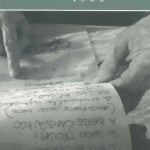TOM LUX (December 10, 1946 – February 5, 2017)
Larry Goldstein was in town this past week, and we had lunch together at the Long Beach Museum of Art, where the upstairs gallery currently features some superb photographs of the Long Beach port. On our way to the museum, as I drove on Seventh Street, Larry mentioned that the Cortland Review was dedicating its next issue to the late Thomas Lux. I hadn’t heard that Tom had died, and I was as grateful for the slow traffic, as for the street’s familiarity. To have been told the same news on the 90 freeway last Friday night, as rain sliced down, might have had a different outcome, for the 90’s lane markers at night are very faint to begin with, and I struggled to detect exactly which lane I was traversing.
I first met Tom back in the early 1990s, when he was on a Southern California reading tour. He started at the Chateau Marmont on a weekend, headed over to Loyola Marymount at the start of the school week, and ended up at California State University Long Beach, by which time we ended up playing pool in the Student Union after his reading. I remember how surprised Tom was when I showed up at the second reading with a copy of Tarantulas on a Lifebuoy. He probably thought at that point that he had met everyone who had a copy of that early book. Not quite, I told him. Contrary to popular allegations from an individual he used to know in New York City, there were more than a handful of astute readers in Los Angeles.
Tom was a superb reader, and his poems fit perfectly into the Stand Up school that Charles Harper Webb was beginning to promote. Indeed, he unquestionably deserved his place in the second edition. He returned to the Los Angeles area in the late 1990s; along with Naomi Shihab Nye, he was the first poet-in-residence at the Idyllwild Poetry Festival. Idyllwild was the last place I saw him, in large part because my life as a scholar has diverted my creative energies outside of the contemporary poetry nexus. It was over a decade ago that we last wrote each other. His poems have been a constant presence in my teaching, though.
Thomas Lux radiated a multi-dimensional love of poetry that went beyond anything I have ever encountered in all but a few other people. If it seems that he is present now in my memory’s eye as a living presence, reciting lines of poetry by Hart Crane or Theodore Roethke to illustrate his point, then it is a measure of how much his invisible companionship has meant to me the past dozen years.
This sense of personal loss extends to Charles Harper Webb, one of my fellow poets at CSULB. I asked if he would be willing to contribute to this blog post about Tom Lux’s writing and presence in our lives and he immediately sent the following eulogy:
“I was beyond bummed to hear of the death of Tom Lux, one of the truly good guys in American poetry. Just last December, I sent him my new book of essays on poetry, and he promised to send me a copy of the collection of Bill Knott’s poems which he’d just finished editing. It never crossed my mind that I’d never see, or even e-mail him again. Since we lived on opposite sides of the country, I didn’t see him much; but he was my friend, and a world-class ally in the fight for clear, entertaining poetry. I love Tom’s poems. I wish I’d written them. Every virtue that I praise in my essays, his poetry exemplifies. Wit, passion, impropriety, brilliance of metaphor and conception—he gave it all to the world in clear, concise language that sounds like no one else. Because there was no one else like him. It’s our good fortune that, although his body’s gone, his voice still sings out of his books, loud and quirky, brave and clear.”
The Collected Poems of Tom Lux will be a book worth waiting for, and the second half of Charles’s assessment would be a spot on blurb for that book. In that kind of volume, it is a common practice to include an index of titles as well as first lines. I would recommend including an index of last lines, too, in that book as a way of giving young poets one more axis of inspiration. I have seen many determined and talented young poets emerging in the past twenty years, but few have the gift of Tom Lux’s quirky, encompassing, comic sense of poignant elucidation.
If I were to take part in a memorial reading, I would be hard pressed to choose which one of his poems to read. “Refrigerator, 1957” would probably be my choice, though given its popularity, someone else would probably have read it by the time I got to the podium. It is certainly one of the best poems to have first appeared in The New Yorker magazine.
https://www.poemhunter.com/best-poems/thomas-lux/refrigerator-1957/
https://www.poemhunter.com/best-poems/thomas-lux/refrigerator-1957/
http://www.newyorker.com/magazine/1997/07/28/refrigerator-1957
http://happopoemouse.blogspot.com/2013/11/number-326-thomas-lux-refrigerator-1957.html
And for a view of that poem “across the pond,” go to:
https://www.theguardian.com/books/2015/jan/16/selected-poems-1986-to-2012-thomas-lux-review
One of the better articles I’ve found on his poetry can be found at:
http://www.cerisepress.com/01/01/life-on-a-piecemeal-planet-god-particles-by-thomas-lux/view-all
https://www.pshares.org/issues/winter-1998-99/about-thomas-lux-profile
Issue 77 / Winter 1998-99 – Stuart Dischell
http://www.news.gatech.edu/2017/02/07/campus-atlanta-communities-mourn-loss-thomas-lux-director-poetrytech
https://www.theatlantic.com/notes/2017/02/thomas-lux-obituary/516354/
http://www.dailyo.in/voices/tom-lux-death-poet-poetry-eulogy-tribute-vijay-seshadri/story/1/15523.html

 About Bill Mohr
About Bill Mohr